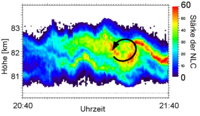Noctilucent cloud (NLC)
Noctilucent clouds (NLC) exist at the edge of space and consist of ice particles that are only a few 10 nm small. So they are less than 1/10 of the wavelength of light or less than 1/100 of a dust particle. The subject of intensive research is how big the particles are in detail and how many particles occur per volume. In particular, the water content of the cloud is essential for understanding NLC.
In addition to understanding the formation of clouds, we can investigate processes in the upper atmosphere just from monitoring the clouds. Most of the processes can not be explored and understood otherwise. Since the cloud particles are so tiny, they follow the movement of the air, at least for a short time almost entirely. Only when the icy particles in the clouds are moved for several minutes or several kilometers, do the microphysical changes of the particles become essential.
NLC are observed with lidar (active) or cameras (passive), sounded in-situ by rocket-borne instruments and simulated using combined microphysical and dynamical models. On the observational side, modern cameras allow studying the motion of a cloud with 10 m accuracy even when the cloud is about 500 km away. Having such a high resolution, the transition from secondary wave motion to turbulence, e.g., in Kelvin-Helmholtz instabilities, becomes visible. Planetary scales of many 100 km are investigated using satellite data and 3-D simulations of the atmosphere and the microphysics of ice. The combination of measurement and modeling of the nanometer scale NLC particles thus helps to improve our understanding of the dynamic processes at the edge of space from scales of a few meters to hundreds of kilometers.
Selected publications
- M. Gerding, G. Baumgarten, M. Zecha, F.-J. Lübken, K. Baumgarten und R. Latteck, On the unusually bright and frequent noctilucent clouds in summer 2019 above Northern Germany, J. Atmos. Solar-Terr. Phys., 217, doi:10.1016/j.jastp.2021.105577, 2021.
- F.-J. Lübken, G. Baumgarten und U. Berger, Long term trends of mesopheric ice layers: A model study, J. Atmos. Solar-Terr. Phys., doi:10.1016/j.jastp.2020.105378, 2021.
- B. Schäfer, G. Baumgarten und J. Fiedler, Small-scale structures in noctilucent clouds observed by lidar, J. Atmos. Solar-Terr. Phys., 208, doi:10.1016/j.jastp.2020.105384, 2020.














